 Research Goals
Research Goals
The goal of the project is to build an anthropomorphic two-armed
robot
together with a multi-camera vision system. The geometry of the system
was inspired by the upper part of a human body, as shown in the
pictures.

- The intelligent workbench
The robot interacts with a human as an assistant in the workbench
tasks. Such tasks could be for example the execution of chemical
analysis, where the human decides what to do and the robot performs the
frequent standard procedures or dangerous parts of the analysis. Based
on simple commands like pick this or pour this into the
robot adapts to become a useful helper for the human. Commands could be
entered using gestures. The robot should use the vision
system to locate and measure objects.
- The semi automomous robot
As before, the robot teams up with a human. It performs simple
manipulative tasks prescribed by the human operator, who can specify
relatively complex tasks of pick-and-place nature. The robot solves the
task by breaking it down into a number of individual pick-and-place
steps autonomously. This property is useful if the operator and robot
are separated by a distance and communication lines are unreliable or
communication carries a time-delay. Another area where such autonomy is
useful is when a robot arm and the visual system is mounted on a
wheelchair and can be controlled by a handicapped person through use of
a simple high-level interface.
Even although the technical realization of such scenarios may be
quite difficult at the current time, we believe that it is necessary
to have such forward-looking goals to bring together
various research directions to focus on a common concrete, tangible
result.
We are concerned with three main classes of problem.
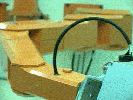 The Manipulator
Hardware
The Manipulator
Hardware
Our arm hardware, as shown in the laboratory overview, is based on two
classically designed industrial manipulators. The motoric and
sensory properties of such devices are naturally light-years away from
their biological counterparts. The development of appropriate
technical solutions for the mechanics and the tactile and visual
sensors for a humanoid robot is still at a very early stage, and as
long as this continues to be the case, with the components remaining as
primitive as they currently are, there is little chance of building a
system even mildly comparable to a biological system, let alone to a
human being. Many other research teams are also working on this
problem. Due to our manpower limitations and the lack of
equipment for shaping metal ourselves, we have to accept this fact and
focus on solving the resulting problems in vision
and control using existing hardware.
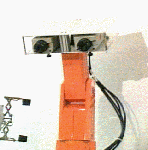 The Vision System
The Vision System
The vision system provides the main sensory
input
to JANUS. It
produces the following pieces of information for the control system:
- A scaled wire frame model of "interesting" objects, e.g. the
objects that are to be grabbed.
- A rough location model of the "less interesting" objects, e.g.
the objects which form obstacles in the movement of the arm.
- Classification of objects as instances of the base model or as
"aliens".
- Location of pointer marks (e.g. a finger tip, or a laser
pointer).
- Recognition of simple gestures (e.g. command pick or place).
The development of the vision system is at a very early stage. To
date
we have set up the technical
preconditions to implement and test various approches to solve the
tasks mentioned above.
There are two prototype implementations for a
model-based classification and
wire-frame
generation.
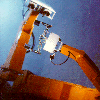 The Control
System
The Control
System
Currently most of our manpower has been
invested
in the development of
the control system (see history of the
project). The control system
is based on a large set of local heuristics that form a community of
reflective adaptive agents
communicating using a blackboard-based logic.
The JANUS Laboratory
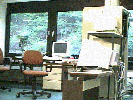 The JANUS
Laboratory
The JANUS
Laboratory
The lab contains the apparatus for experiments with the manipulators and the vision
hardware.
This includes a PC cluster which is used to run the
arm
control and vision software.
 The Manipulators
The Manipulators
The manipulators are mounted on a wall
above a
2x2 m table. The
experimenter can stand in front of the table and may reach into the
cell to
add or remove objects or to point at things. The following picture
shows
one of the manipulators in detail.
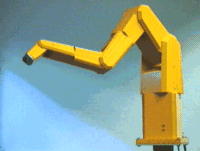
|
A few facts about the manipulators.
- manufactured by NIKO (a German company)
- 8 degrees of freedom
- outstretched length about 1.5 m
- maximal payload at hand is about 1 kg
- weight of the whole arm is about 40 kg
- driven by DC motors
- each joint contains an incremental angle decoder
- the maximal rotation speed of the joints is about 60
degrees per second
|
We chose this arm because, compared to more
standard arms, the
geometry fits quite well to human-like usage. Our kind of arm control
is different to that used in industrial methods, therefore we were
forced to build our own motoric control and
amplifier hardware to ensure optimal controllablity of the
manipulators.
The Grippers
A two finger gripper is mounted at the tool
center plate of both manipulators.
The gripper has the following charateristics.
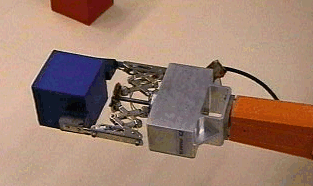
|
- manufactured by PRAEMETA
(a German company)
- two parallel sliding fingers
- contact switches at the end of each finger
- jaw width from 5 cm to 15 cm
- DC motor driven
- incremental decoder at the motor
- weight about 400 g
- needs about 10 seconds for full close/open
|
We chose this kind of gripper because the DC
motors
allow continuous
control of gripper jaw width. Additionally the pincer extendors
allow a large stroke between open and close gripper. The
contact switches allow the grasping of objects with a given
force. A disadvantage is that the fingers require some time to
close and the gripper itself is somewhat heavy.
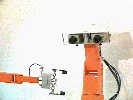 Vision Hardware
Vision Hardware
The vision system consists of a stereo camera
mounted in the "head" of JANUS
and of a few (3-5) cameras mounted on tripods around the table.
The "neck" is comprised of a basic two-joint manipulator.
We
use SONY color CCD cameras due to their low price. The
cameras are connected to a Microtron MFG Inspecta frame grabber, which
is able
to grab frames with a few hundred Hz.
 The low level motor driver
The low level motor driver
All motoric joints including the two
manipulators, the grippers and
the head are driven by DC motors with the same kind of interface. This
enables us to build a standard amplifier and PID module for all kinds
of motoric activities. At the moment we have in total 20 joints to
control. As PID controllers we use MTC2 cards (manufactured by JANZ)
mounted in two industrial 486/100 PCs running Linux. The amplifier
module is a simple DC amplitude modulated amplifier. By avoiding a
phase modulation amplifier, we reduce the AC components of the motor
power supply to nearly zero, which gives us optimal smooth and
stable motor behaviour. A drawback of our "old fashioned" way of
control is that we need a little "cooling tower" to carry away the
extra heat generated.
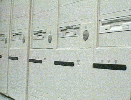 The
PC Cluster
The
PC Cluster
All arm control
and vision algorithms of our system
are based on
many concurrently running local heuristics. These heuristics form
agents that communicate via various blackboards. The philosophy of
such algorithms allows a highly parallel model of execution. Our
control algorithms use in all a few hundred independent processing
units. Unfortunately we can't afford so many processors, therefore we
use sequential scheduling that enables execution on a few
CPUs. Initially the system was developed to run on a single SUN Sparc
20 computer. Meanwhile we have constructed a cluster of Pentium 166
PCs connected by a 100 Mb Ethernet. A few SUN workstations
serve as terminals. The cluster computers run Linux as their operating
system. The blackboards are mirrored across the cluster to enable the
agents to communicate without knowing anything about the connectivity
of
the cluster. This method is used for both manipulator control and
the vision system.

 Research Goals
Research Goals 
 The Manipulator
Hardware
The Manipulator
Hardware
 The Vision System
The Vision System
 The Control
System
The Control
System
 The JANUS
Laboratory
The JANUS
Laboratory
 The Manipulators
The Manipulators
 Vision Hardware
Vision Hardware
 The low level motor driver
The low level motor driver
 The
PC Cluster
The
PC Cluster